

GLTN / UN-Habitat Publications
|
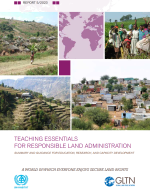 |
Teaching Essentials for Responsible Land AdministrationAuthor: Stig Enemark The Teaching Essentials for Responsible Land Administration is a structured knowledge base on responsible land administration, developed by the Global Land Tool Network. The knowledge base consists of six modules, each about 70 pages long, and covers all the key aspects of responsible land administration. The six modules are available in English and French on the GLTN e-learning platform, www.elearning.gltn.net. They are aimed primarily at universities and training institutions that offer courses on various aspects of land administration in the developing world. The six modules are:
This guide is an abridged version of the Teaching essentials. It provides an introduction to responsible land administration, a summary of each of the six modules, and guidance on how to use the modules for e-learning, university education, research activities, capacity development and training, and professional practice. It also offers recommendations for applying hte principles of responsible land administration at the country level. |
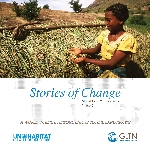 |
Stories of ChangeThis publication is a collection of stories that illustrate outcomes of selected projects from the GLTN Phase 2 programme 2012-2018 at both global and country levels. |
|
|
|
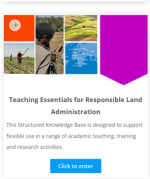 |
Teaching Essentials for Responsible Land AdministrationTAlthough there is considerable knowledge available on land related issues and innovative land tools and practices, most of this information is partly unknown and/or fragmented among university teachers, or it is hidden within broader land related curricula. To redress this, partners within GLTN’s International Research and Training Institutions Cluster have prepared a Structured Knowledge Base to support design and teaching of Responsible Land Administration curricula at universities and training institutions. The partners involved included: RMIT University, University of East London, University of Florida, University of West Indies, University of Twente, Aalborg University, Ardhi University, Technical University of Munich, NELGA (Network of Excellence in Land Governance in Africa) and UN-Habitat. Content: Six modules have been prepared and released as Beta versions in PDF format:
|
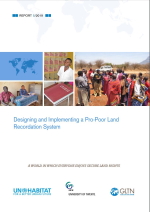 |
Designing and Implementing a Pro-Poor Land Recodation SystemThe challenges to tenure security in both urban and rural areas are not only large, but they are increasing due to the different types of pressures making land more and more scarce. There is growing acceptance that only by recognizing and supporting a continuum of land rights, can tenure security be reached for all people in an inclusive way. GLTN’s partner network began implementing this vision in 2006 with the development of land tools, 18 of which have now been designed and tested, and are increasingly implemented at scale. The pro-poor land recordation system outlined in this publication is one of these tools, and is designed to be implemented on its own or, better, in combination with other land tools to reach inclusive tenure security. |
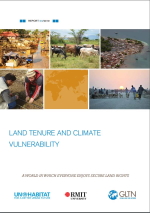 |
Land Tenure and Climate VulnerabilityThis publication examines the inter-relationships between land tenure and climate vulnerability. The analysis has been framed according to peoples’ exposure to climate-related hazards, the sensitivity of different elements at risk in both urban and rural contexts and understanding how insecure land tenure influences the adaptive capacity of communities and individuals. Potential feedback loops from climate adaptation measures that may act to undermine peoples’ security of tenure have also been considered. The publication has been written with a broad audience in mind, including development, climate change adaptation, disaster risk reduction, emergency management and land sector communities of practice. The aim is to highlight some of the complex and inter-linked challenges facing marginalized communities and, based on this evidence, signpost possible pathways to positive change. The content herein draws from an extensive literature review and evidence from five international case studies contributed by regional experts. The case studies were selected to enable consideration of differing land tenure and climate vulnerability contexts in different parts of the developing world. |
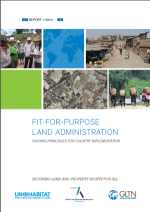 |
Fit-For-Purpose Land Administration - Guiding Principles for Country ImplementationThis publication is primarily designed to allow a range of stakeholders in developing countries to understand the overall Fit-For-Purpose approach and to recognize the benefits of adopting this approach. The Fit-for-Purpose solutions provide opportunities for land administration systems to deliver benefits, including secure tenure rights, to a wide range of stakeholders within a relatively short time and for relatively affordable costs in a flexible manner. It provides structured guidance on building the spatial, legal and institutional frameworks in support of designing country-specific strategies for implementing FFP land administration. It contains the analysis and operational advisory guidelines to implement the approach. Authors of the Guide are Stig Enemark, Robin McLaren and Christiaan Lemmen and it is published by UN-Habitat/GLTN and Dutch Kadaster. |
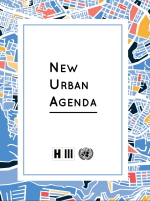 |
New Urban AgendaThe New Urban Agenda was adopted at the United Nations Conference on Housing and Sustainable Urban Development (Habitat III) in Quito, Ecuador, on 20 October 2016. It was endorsed by the United Nations General Assembly at its sixty-eighth plenary meeting of the seventy-first session on 23 December 2016. The New Urban Agenda represents a shared vision for a better and more sustainable future. If well-planned and well-managed, urbanization can be a powerful tool for sustainable development for both developing and developed countries.
|